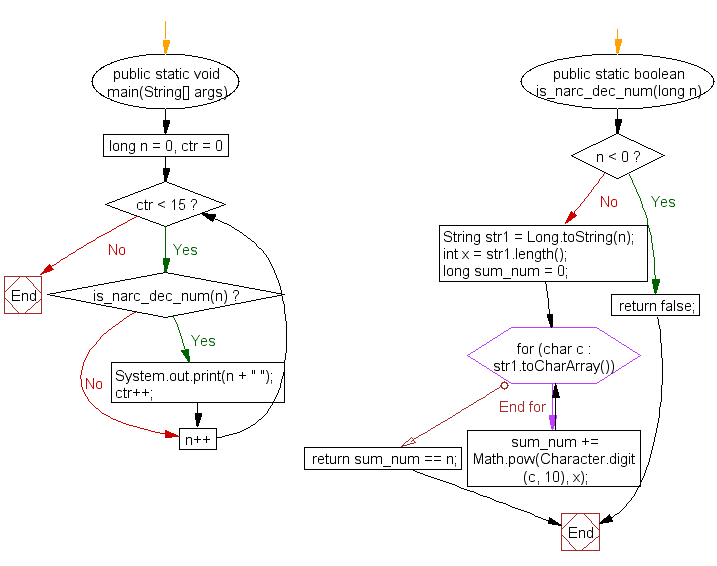Java: Generate and show the first 15 narcissistic decimal numbers
First 15 Narcissistic Numbers
Write a Java program to generate and show the first 15 narcissistic decimal numbers.
A Narcissistic decimal number is a non-negative integer, n that is equal to the sum of the m-th powers of each of the digits in the decimal representation of n, where m is the number of digits in the decimal representation of n.
- if n is 153
- then m , (the number of decimal digits) is 3
- we have 13 + 53 + 33 = 1 + 125 + 27 = 153
- and so 153 is a narcissistic decimal number .
Narcissistic numbers in various bases :
The sequence of base 10 narcissistic numbers starts: 0, 1, 2, 3, 4, 5, 6, 7, 8, 9, 153, 370, ……
The sequence of base 8 narcissistic numbers starts: 0, 1, 2, 3, 4, 5, 6, 7, 24, 64, 134, 205,….
Pictorial Presentation:
Sample Solution:
Java Code:
// https://rosettacode.org/
public class Example6 {
public static void main(String[] args){
for(long n = 0, ctr = 0; ctr < 15; n++){
if(is_narc_dec_num(n)){
System.out.print(n + " ");
ctr++;
}
}
System.out.println();
}
public static boolean is_narc_dec_num(long n){
if(n < 0) return false;
String str1 = Long.toString(n);
int x = str1.length();
long sum_num = 0;
for(char c : str1.toCharArray()){
sum_num += Math.pow(Character.digit(c, 10), x);
}
return sum_num == n;
}
}
Sample Output:
0 1 2 3 4 5 6 7 8 9 153 370 371 407 1634
Flowchart:

For more Practice: Solve these Related Problems:
- Write a Java program to check if a number is narcissistic by recursively summing its digits raised to the power of the number of digits.
- Write a Java program to generate the next narcissistic number after a given input using an iterative approach.
- Write a Java program to find all narcissistic numbers within a specified range using Java streams.
- Write a Java program to compare the performance of recursive and iterative approaches in generating narcissistic numbers.
Go to:
PREV : Seed Lychrel Numbers.
NEXT : First 10 Lucas Numbers.
Java Code Editor:
Contribute your code and comments through Disqus.
What is the difficulty level of this exercise?
Test your Programming skills with w3resource's quiz.
